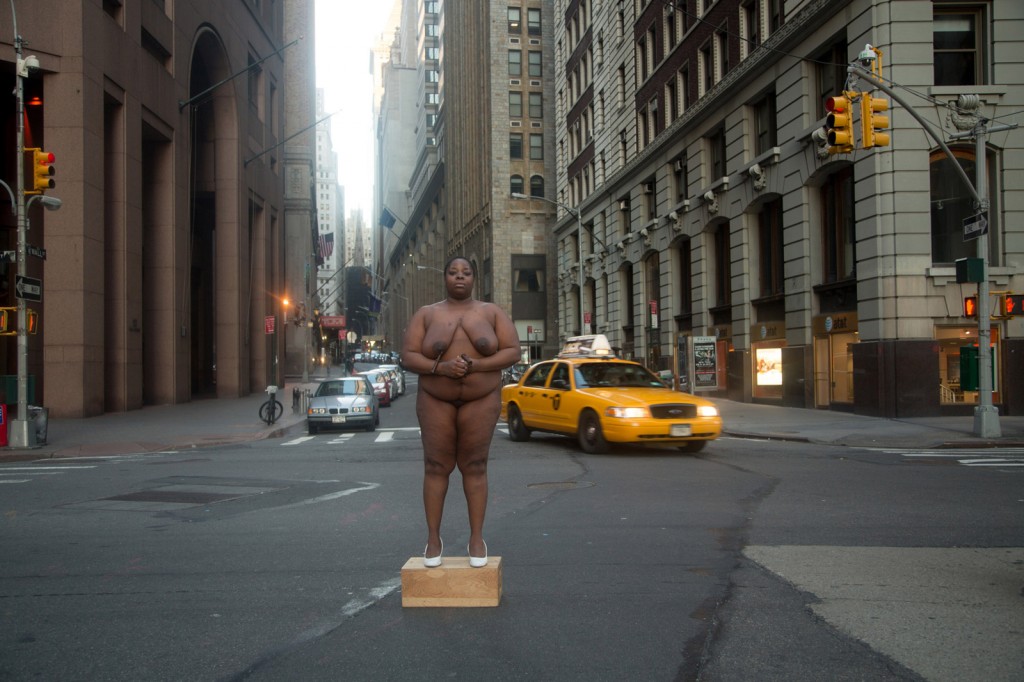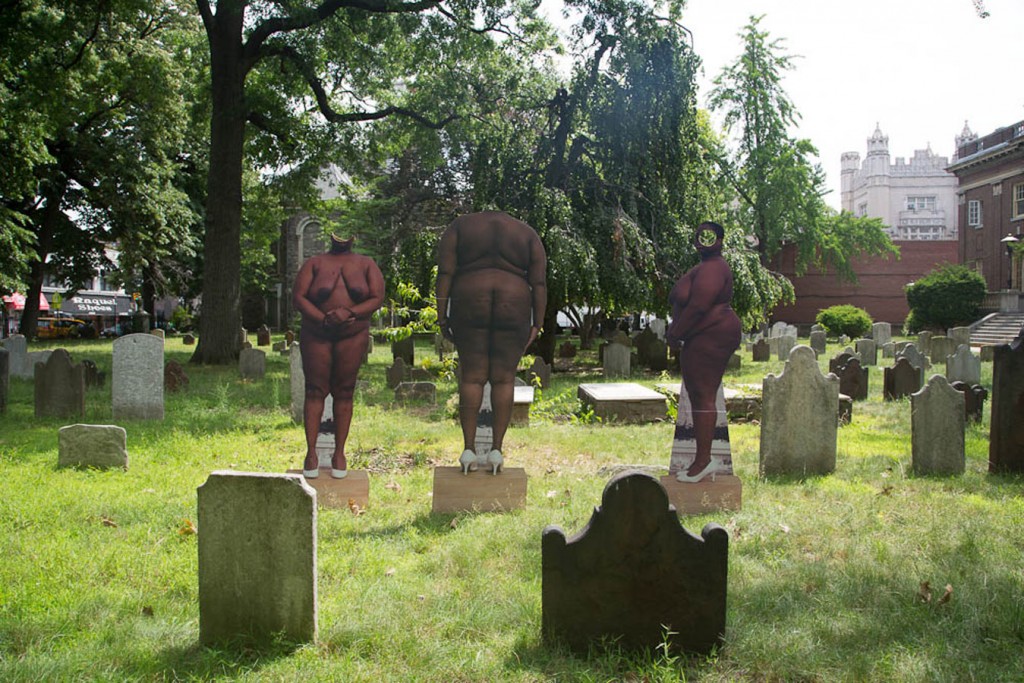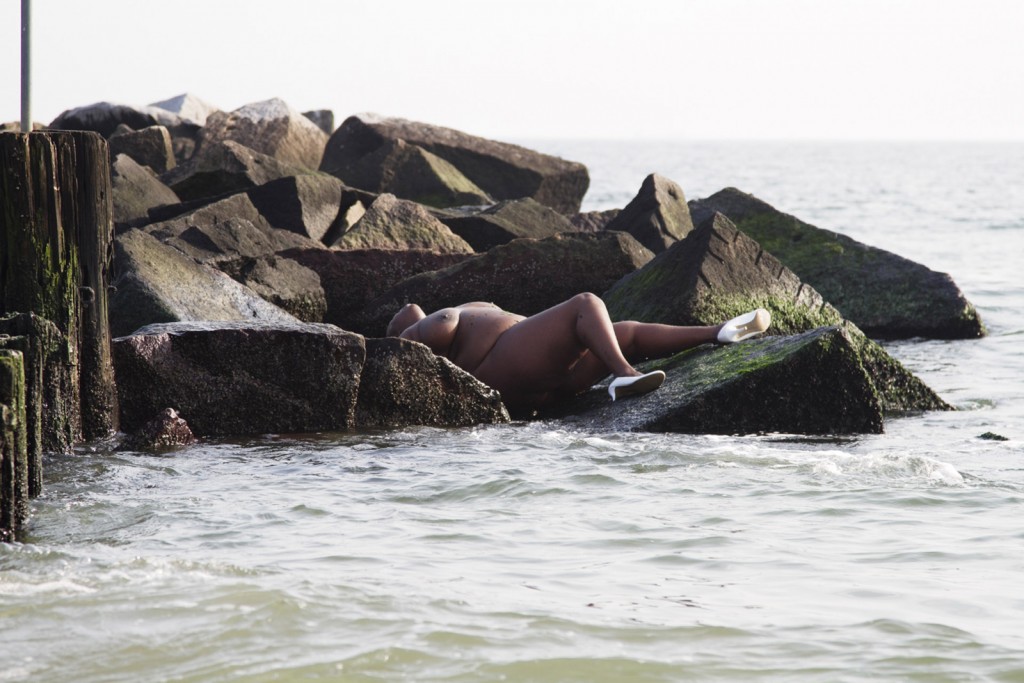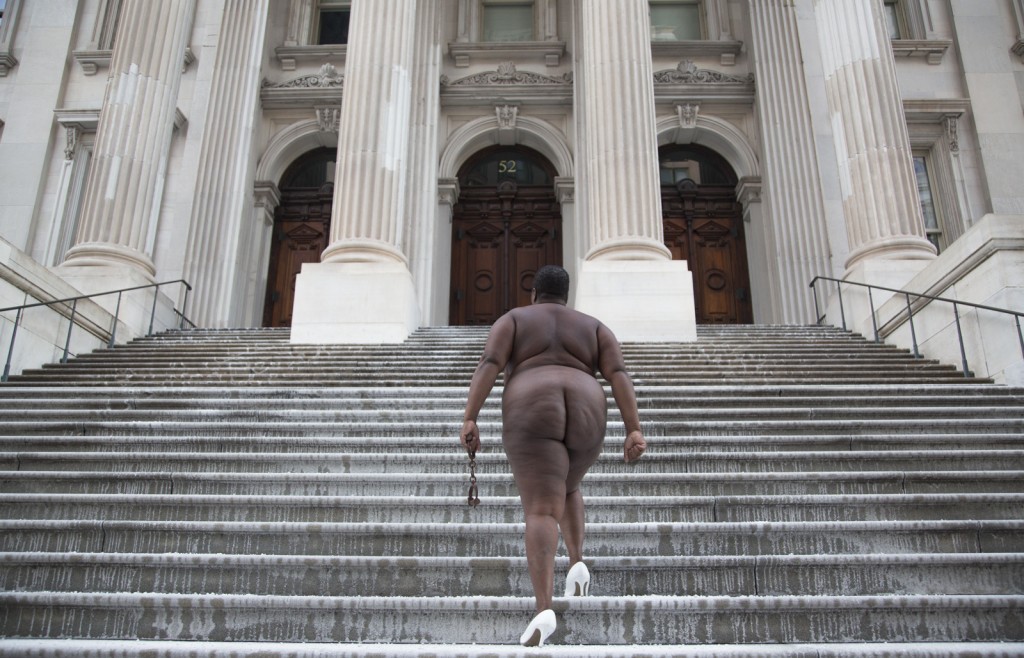
From Her Body Sprang Their Greatest Wealth
Nona Faustine is a Brooklyn native and graduate of The School of Visual Arts and the ICP-Bard MFA program. Her work explores womanhood, the Black American experience, history and folklore, gender, and identity politics. Her current work, the White Shoes series, are self-portraits taken in and around New York City at locations with ties to slavery. The photos feature Faustine, nude save a pair of white pumps, sometimes on what looks like an auction block, in various slave auction or burial sites in NYC. [PANK]’s Ashley M. Jones (AMJ) chatted with Faustine (NF) about her White Shoes series, art’s responsibility, and what’s on the horizon for Faustine’s art.
AMJ: I’d love to know more about your creative process. Do the images appear to you, do you happen upon them? How does it all work?
NF: The work is about being in places of slavery or where history is very strongly linked to these places. Then, there’s the self-portrait. So it’s really me finding these places and putting myself in those places. Most of them are forgotten, not known—except for the African burial ground—so it’s just a matter of me finding these places and then deciding what I want to say in them, and calling attention to them. It’s sort of an instinctual process. Once I find these sites and find out about the history of them, it’s sort of instinctual as to what I do. The nudity part is the easy part…well, not so easy. It’s still very hard for me at times.
AMJ: I know that the White Shoes series aims to illuminate the black body, power and powerlessness, and history’s imprint on the present. Can you talk a little bit about reactions you’ve received from this project?
NF: I think that people really do understand it. Particularly people of color. I mean, they see what is happening to black bodies now and [what] has been [happening]. They see themselves put in the images, and we as people of color, we have this long history and relationship with oppression. History is written across our bodies—we see it when we see a black face. It’s sort of instinctual. That kind of oppression and brutality goes hand in hand with the black body but there’s also a beauty there. There’s so much more than sadness in the black body. There’s so much grace, there’s so much strength, there’s so much beauty, there’s so much knowledge. When you look at a black body, to me—and perhaps to other people, too—when you look at a black person, you read so much depth and complexity.
People have embraced the work tremendously. I am looking at social media because that’s how the public was introduced to my work. I read the comments and things like that—people tell me I shouldn’t, but I can’t help it. And they also contact me. I’ve been contacted by many people who have come across the work and their response is so heartfelt. It comes from the heart and is so sincere. They just say things and they encourage—they love the series but they also encourage me, they also say how they’ve connected with the work, how they’ve been moved by it. It’s not only from people of color, but white people, too. One guy told me about his family history, and how he has slave owners in his family’s history and how it really made him think of his own personal history. And then Black women who are just dying to see a real, full representation of who they are, you know. An ordinary woman, not a celebrity. And a lot of people are also in pain; they just want something that connects and expresses their pain. But also people are very appreciative of the work as a piece of art, and that’s always the first thing that I want people to connect with as well, to look at it as a piece of art, worthy of doing what art does—moving us, making us ask questions about who we are and how we got here. And [I’m] looking at the canon of photography and what I’m saying and contributing to that historically, and they’re getting it.

Of My Body I Will Make Monuments In Your Honor
AMJ: What this project has done to or for you, personally/spiritually?
NF: Well, you know you make the art for yourself because that’s number one. You make it because you have to. I had to. There was something deep down in my soul that was very pressing and that I had to do. It became like a therapy for me, speaking about all the things that I felt about society and history and myself as a new mother, as a woman, as a black woman, [and] as an artist starting the series in grad school, and so personally, it has liberated me. It has given me courage and strength and it has boosted my self-esteem—not that I lacked self-esteem—but it has empowered me.
AMJ: Although I’ve never stood, naked in a crowded city, and I’m sure everyone is asking this, but I have to ask, too. How did you prepare yourself for this project? Did the need to make the art overpower our human urge to hide?
NF: For me, after I had had my baby my whole life and perspective changed about who I was as a woman and my body and my connection to that. And, of course, growing up, as a teenager and as a young woman, you develop these complex issues around the body, and particularly if you’re a plus sized woman—and I’ve always been a big girl—so you are constantly dealing with the messages that society’s sending you, that your family’s sending you, and there’s you and how you feel about it. And then at a certain point, like when I had my baby, it was like I just wanted to celebrate the body, but I also wanted to talk about that thing that has held many of us down and many of us back as women. To hide, to be shamed and be ashamed of your big breasts, your big behind, your big thighs, whatever, and it was like, you know, I just wanted to clapback society, and also talk about how the body has been used. The black female body has been used as a breeder as a work horse, all these things, but we’re triumphant, and the body is triumphant, and my body is that. Somehow I connected that and also the beauty.
I spent that summer when I first started the project—the summer before—spending it at the beach for the first time, and seeing all these bodies that were all different sizes and saying yes. And I think what happened was that through all of that, the project became so passionate, the ideas—I became so passionate about it, I just had to do this. Once I decided to do the nudity, I knew that that was it for me. That was a personal choice that I choose to make, not speaking for anybody else, speaking for me, and I had to do it that way. And I felt that for one, you weren’t seeing, in art, my type of body. That was one thing I was not seeing, and if you saw it, it was as Sarah Baartman, the Venus Hottentot, you know, who was depicted as a freak, and I’m coming at it from that historical point of view, but from the present and it’s a celebration. And a declaration, so it’s the total opposite in that respect. So once I decided to go forward with the nudity, like, I had to and it was important.
AMJ: To me, there’s no shame in the images. When I look at it, I don’t read shame at all.
NF: But you know, some people, they are ashamed. I have seen comments from people saying, oh, you need to lose weight, you looked ridiculous. But those are problems they have with themselves. You hear white men, and some black men who talk in a bad way about it. But of course those issues are their own and they really don’t have anything to do with me. They have something to do with how they have been conditioned by their society, not only to hate people who are different but also [hate] themselves.
AMJ: You said in an interview that “artists serve as the world’s conscience.” I believe that, too, and I wonder if you’d talk more about what you wanted to tell the world as its conscience with this series, and with your art as a whole. What was missing from the world’s thought stream that you sought to add?

Like A Pregnant Corpse The Ship Expelled Her Into The Patriarch
NF: I sought to make the world in remembrance. And [I sought to make] a memorial to African slaves who were brought here. At the heart of the work, those sites are all we have left of a history and a people who contributed to building a country, a nation. And a city, the city of New York. That’s at the heart of what I’m talking about. And there’s hardly any places to go to mourn, to reflect about these people. They’ve been buried. In New York, they’re buried under twenty-five feet of landfill. Literally, they’ve put twenty-five feet of landfill over those graves. So we’re in the foundation, so to speak, of our city and of our country. The United States’ economy was built on slavery. You cannot deny that. They’re writing books, they’re analyzing, scholars are breaking it down to the decimal point. For us not to have a museum or a place—the United States government pretty much doesn’t even recognize it, and I felt like that was a big thing I wanted to do, and I’m not saying that I fully did it—I’m just saying that I needed to make that contribution, and I wasn’t seeing that. And that that was something that was deep inside me that I wanted to talk about, you know? I just needed to talk about it. I felt like it was an invisibility/visibility kind of thing. Truly, in this case, it is a visibility invisibility thing. You see the descendants of the African slaves every day in us, but they’re not recognized as the contributors of this nation that they were. To me, they made the ultimate sacrifice. They survived that long journey across the transatlantic, sometimes they died, oftentimes they were murdered, they were thrown overboard, but the ones that made it here and that were able to have children who had children—we’re the ultimate survivors.
AMJ: Your work, to me, shows that you feel responsible to deliver thought-provoking art. What would you say is the artist’s responsibility?
NF: You know, it’s very personal for each artist. I think all of art in some way does that. I think art and artists are not only responsible for filling the world with beautiful objects and things, but I think they’re also doing something to move us—move us to action, move us to remember, move us to think about complex issues, and I think much of the best artwork does that, at least for me. When I see work by Barbara Kruger, she’s one of them, one of what I would call like the activist type of artist. But also work by Andy Warhol, who talks about commercialism and consumption, who talks about who is seen and who is considered beautiful and what is beauty. He talks about our society—there’s a series he does about the protests—the civil rights protests in Alabama and Mississippi. He does a series of images of the protesters being bitten by dogs and the police beating on them and then he colors them, and he’s zeroed in on that moment of brutality in such a way, and it grabs you. And that’s what art does. That’s the power in it.
AMJ: What’s next for you? Are you working on any special projects?
NF: I have a solo show January 9th at Smack Mellon. I’m still continuing the White Shoes—there’s so many [to do]. The thing about why I’m continuing it: one, it’s a very big topic, a lot of places still to go. But there’s still this overwhelming denial and [there are] revisionists at work, trying to cover up, deny, play down not only slavery and what happened in slavery but the places [which] are being erased. Literally being erased and covered up. For instance, there’s a place in Virginia, and it was a port where slaves were brought and sold, and they’re trying to build a stadium there. There’s still a lot of places I need to go—I don’t care what anybody says. I need to go, I need to document it because I believe it’s important [for] the future—our children, our children’s children. [It’s important] that there’s some kind of record.
I saw, at the Met, a beautiful show of African photographers documenting their time, portraits of people, beautiful women, Black women with these elaborate hairdos, these women would go to Malick Sidibé’s studio, and they’d be dressed to the nines, and it took place in the 1960s and 70s, and some of them even further back, but it is an example of the beauty and the work of Africa. We were told that there was nothing there—that there’s no civilization, there’s nothing worthy of celebrating and holding on to. I was like, in 100 years, 200 years, [it is important] for these images, for people to see how we reacted to our environment and what was going on. I would like for there to be a documented testimony to our time. I think about that because a lot of time you wonder, where’s the record for back then? What was it like? What did people feel, what did they think? And I just felt like that was going to be my piece to the puzzle, this series.
I’m also always working on other things like for instance, every summer I go to Coney Island and I take pictures of people on the beach—they don’t know it—but I’m taking pictures of them. It’s called From My Beach Chair, because that’s where I’m sitting. And then I’m also taking pictures of my family—I love portraiture, and I’ve been documenting my family. We’re a multi-generational household—four women in my house—my mother, my sister, my daughter and I, and I’m taking portraits of them as well. So I have my hands in a lot of different things.
—
For more info about Faustine, White Shoes, and other work, visit her website.
White Shoes opens at Smack Mellon on Jan. 9th at 5pm. It runs until February 21st. Faustine’s work was selected as an Honorable Mention in the 2014 Camera Club of New York Competition, and it has received coverage at The Huffington Post, Hyperallergic, Greybook Magazine, Dodge and Burn Blog, and other publications. Faustine’s work has been exhibited in “For Colored Girls” at the Shomburg Center for Black Research in Harlem, “Respond” at Smack Mellon, and in “Take 10 at the International Center of Photography.” Faustine will open her solo show, White Shoes, on Saturday, January 9th from 5-8pm at Smack Mellon. The show will run until February 21, 2016.
AMJ
Over My Dead Body
![[PANK]](https://pankmagazine.com/wp-content/themes/pank/assets/images/pank-logo-large.png)

